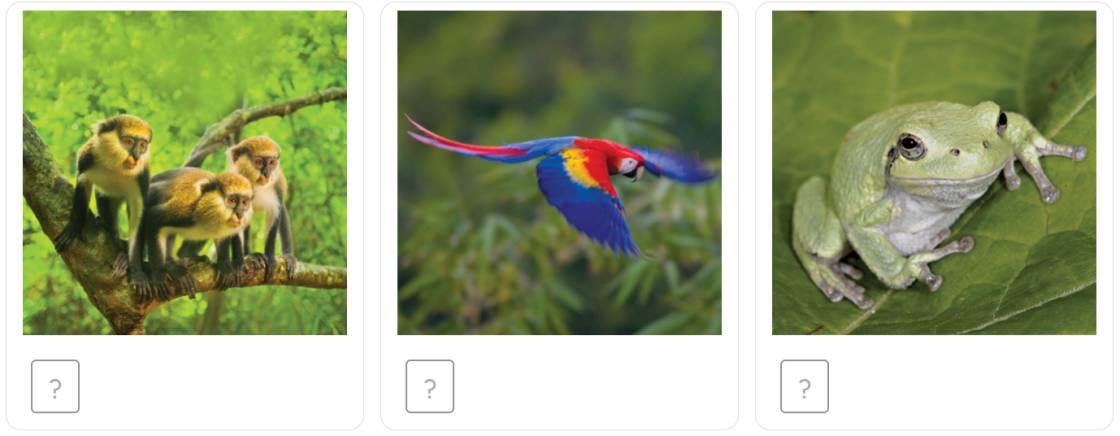A. Listen. Number the animals.

Hãy nhập câu hỏi của bạn vào đây, nếu là tài khoản VIP, bạn sẽ được ưu tiên trả lời.


Đáp án là B
biodiversity : đa dạng sinh học
Các từ còn lại: extinction: sự tuyệt chủng; habitat: môi trường sống; conservation: sự bảo tồn

Đáp án : C
Biodiversity = sự đa dạng sinh học. Extinction = sự tuyệt chủng. Habitat = môi trường. Conservation = sự bảo tồn

Over the last two decades a new means of spoken (1) ........................ has emerged: the mobile phone.When Scotsman Alexander Graham Bell invented the telephone in 1876, it was a revolution in communication. People could talk to each other over great (2) ......................... Now telephone is used to take (3) ........................, access to the (4)....................... or watch video clips.
1. A. communication B. languages C. voice D. accents
2. A. speeds B. distances C. ways D. transmissions
3. A. pictures B. images C. sounds D. photographs
4. A. networks B. wifis C. Internet D. media
Question 2. Listen again and choose A, B, C or D for the sentence (1pt)
5. The real first mobile phone call was made in ..................?
A. 1986 B. 1987 C. 1973 D. 1876

Đáp án : B
Biodiversity = sự đa đạng sinh học. extinction = sự tuyệt chủng. habitat = môi trường sống. Conservation = sự bảo tồn

Đáp án D.
danger(n): mối nguy hiểm
dangerous(adj): nguy hiểm
endanger(v): gây nguy hiểm
endangered(v): nguy cơ tuyệt chủng
Dịch nghĩa: Hàng nghìn giống loài động thực vật đang có nguy cơ tuyệt chủng và số lượng
loài giảm mỗi năm.

II. VOCABULARY- GRAMMAR ( 2.5pts) Choose the word whose main stress is marked differently from that of the others (0.5pt)
9. A. dogsled B. worthwhile C. vendor D. barber
10. A. generation B. entertainment C. seniority D. illiterate
Mark the letter A, B, C or D to indicate the correct answer to each of the following questions.
11. Remember to _________ your shoes when you are in a Japanese house.
A. put off B. turn off C. take off D. give up
12. I used to __________ a teddy bear, but I don't have one now.
A. having B. have C. has D. had
13. Jane can’t swim fast. She wishes she __________ faster.
A. can swim B. swam C. would swim D. could swim
14. They suggested that she _________ her parents about her problems.
A. told B. should tell C. tells D. telling
15. He told me he _________ leave the city the next day.
A. has to B. had to C. would have to D. will have to
16. Hoi An is ____ for it old, small and tile-roofed houses.
A. well-dressed B. well-organized C. well-known D. well-done
17. She will get good marks if she _________ hard
A. studies B. studied C. study D. studying
18. There is a big _____of handicrafts made by different craft villages.
A. collect B. collection C. collector D. Collecting
III. Read the following passage and mark the letter A, B, C, or D on your answer sheet to indicate the correct answer to each of the questions. Living in a city has a (19)________of drawbacks. Firstly, there are many problems of traffic jams and traffic accidents. The increase in population and the increasing number of vehicles have caused many accidents to happen every day. Secondly, air pollution negatively affects people’s health, and it also has a bad influence (20)____ the enviroment. More and more city dwellers (21)________ from coughing or breathing problems. Thirdly, the city is noisy, even at night. Noise (22)______ comes from the traffic and from construction sites. Buildings are always being knocked down and rebuilt. These factors contribute to making city life more difficult for its residents.
19. A. lots B. numbers C. number D. numerous
20. A. on B. at C. by D. for
21. A. suffer B. differ C. recover D. flew
22. A. polluting B. polluted C. pollution D. pollute
IV.Read the following passage and mark the letter A, B, C, or D to indicate the correct answer to each of the questions.
Traditionally, rural villages in Vietnam produced handicrafts when they were not busy with planting or harvesting crops. Over time, many villages developed the expertise to make specialised products and so particular villages became famous for such things as weaving, woodwork, lacquer work and metal products. With industrialisation many villagers moved to the cities but maintained their craft skills and networks to produce products for the city market, for example craft villages make furniture, grow flowers or make utensils for the urban population. Other villages changed from making traditional crafts to producing different products desired by an industrialised society. For example, the villagers of Trieu Khuc changed from traditional paper making to recycling plastic. There are now many craft villages in Vietnam based on recycling plastic, paper or metal.
23. When do rural villages in Vietnam produced handicrafts traditionally?
A. When they were not busy with planting or harvesting crops.
B. When they were busy with planting or harvesting crops.
C. After they finish harvesting crops.
D. Before they finish harvesting crops.
24. What do many villages developed over time?
A. They developed the expertise to make daily products.
B. They developed the expertise to make specialised products.
C. They developed the expertise to make their own furniture.
D. They developed their old furniture.
25. What does the word “maintained” in line 5 refer to?
A. ignored B. made C. conserved D. improved
26. Which of the following is NOT TRUE?
A. Rural villages produced handicrafts in their free time.
B. Some villages were popular with weaving, woodwork, lacquer work and metal products.
C. Many craft villages based on farming.
D. Some villages make furniture, grow flowers or make utensils.
1- monkey
2 - frog
3 - parrot